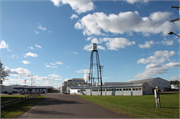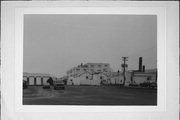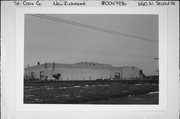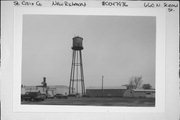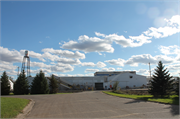Property Record
660 N 2ND ST
Architecture and History Inventory
| Historic Name: | FRIDAY CANNING CO. |
|---|---|
| Other Name: | LAKESIDE FOODS, CHIQUITA |
| Contributing: | |
| Reference Number: | 47936 |
| Location (Address): | 660 N 2ND ST |
|---|---|
| County: | St. Croix |
| City: | New Richmond |
| Township/Village: | |
| Unincorporated Community: | |
| Town: | |
| Range: | |
| Direction: | |
| Section: | |
| Quarter Section: | |
| Quarter/Quarter Section: |
| Year Built: | 1916 |
|---|---|
| Additions: | 2007 2013 1989 |
| Survey Date: | 19832018 |
| Historic Use: | industrial bldg/manufacturing facility |
| Architectural Style: | Astylistic Utilitarian Building |
| Structural System: | |
| Wall Material: | Concrete |
| Architect: | |
| Other Buildings On Site: | |
| Demolished?: | No |
| Demolished Date: |
| National/State Register Listing Name: | Not listed |
|---|---|
| National Register Listing Date: | |
| State Register Listing Date: |
| Additional Information: | The Friday Canning Company, located at 660 North Second Street, began as a single processing plant constructed in 1916 by the New Richmond Cooperative Packing Plant, a slaughterhouse. The plant had a non-extant water tower, smokestack, and a few outbuildings. When the packing company failed and went of business in 1921, A. C. Friday and Son purchased the empty building in 1925 and began their own canning venture drawing on the vegetables produced by regional farms. Much of the work at the canning company was seasonal in nature and required extensive storage facilities and refrigeration. While the extant core building was constructed in 1916, other additions and sheds have been added through its history in 1935, 1952, 1961, 1962, 1963, 1964, 1966, 1967, 1973, 1975, 1982, and 2004. The company was established by A. C. Friday. His son Carleton A. Friday and grandson Fritz Friday continued to operate the company into the 1990s. In 1992, the Friday Canning Company was sold to Chiquita Brands International. The plant was then sold to the Lakeside Foods Company in 2009. The older (1915) section of the plan has concrete exterior fabric, is three and four stories tall and has a flat roof and numerous windows. There are smokestacks. One story concrete and aluminum shed additions surround the older facility. Arched, gable and flat roofs are found on these buildings. A tall watertower sits near the plant. The plant is in the northwest section of the city. It is next to the railroad tracks. There is only one open entry into the area. Because of the way it is situated it is very hard to see. The buildings and the watertower are the most visible part of the complex. The exterior appears to be basically unchanged on the 1915 part. The interior has most likely been modernized throughout the years. Much of the original integrity remains. Architecturally this complex has no outstanding characteristics or details to give it significance. Its significance lies in the dhistorical role it hsa played in the development of the community. See SC32-13 and SC32-30 for views of the watertower and north side of the plan respectively. Background In 1915 Inter-County Co-operative Packing Company was organized and a plant built. It had stock of $317,000.00 sold but not all was paid for. The plant cost over $200,000.00 and was capitalized at $350,000.00. The company did not prosper and in August, 1925, A.C. Friday & Son, a canning company, bought the builldings for $20,000.00. They converted the plant into a pea cannery. Albert C. Friday was a pioneer canner in Wisconsin. He was president and field manager at Badger Canning. He also helped establish the first pea cannery in Markesan and raised peas in Green Lake County for a cannery. His son Carleton A. had worked at Badger Canning Company in Beaver Dam as assistant manager and treasurer. This cannery merged with four others. The Friday's sold their interest in it. Carleton was in charge of the New Richmond factory preparation and later on, its management. He moved to 222 West First Street (see SC20-2) in 1925. It was planned to expand the new plant eventually. A cooking room and sheds for viners would be needed. After peas would be bean canning. The company would help both farmers and merchants by buying cash crops and, therefore, providing more money to spend on retail goods. The newspaper noted "it will help to bring about some of the things St. Croix County needs most: smaller farms, better farmed, more population and more prosperous farmers." Henry Dorn moved to the city to be foreman. He had helped in the remodeling and building of other canneries at Neillsville, Wisconsin Rapids and Hortonville. The first packing was in 1926. This was 36,000 cases of company grown peas. By June of 1927, one million cans were processed. $30,299.00 in gross returns went to farmers and $20,000.00 went for labor. In 1973, 3 1/2 million cases of canned goods were processed. Over $1,000,000.00 was paid to farmers who had planted on 10,000 acres. Peas, beans, corn, carrots, beets, potatoes, mixed vegetables, special dietary items and institutional packs are now canned. Country Gardens Canning was acquired in 1967. They have plants in Coleman and Gillet. There are approximately 80 full time and 250 seasonal employees. Packing is done for groceries' private labels and company owned labels. What began as an operation where soldering was done by hand is not fully automated. In 1977 it was Wisconsin's largest private label canner and the sixth largest in the state. The Friday family still operates the company. Corporate offices are separate from the plant and are at 150 West First Street (SC29-30). The land surrounding New Richmond has been, and still is, agricultural. Much farming is dairying today. The canning company is repres4entative of an early and continuing attempt to combine agriculture and industrialization. It has made an important contribution to the continuation of farming in the area, as well as providing employment for the city itself. Friday Canning is the second major employer in the City (Doboy and Domain is teh first, see SC31-8, 215 North Knowles Avenue). Because of its pivotal contribution to the economic climate and, therefore, the development of the community, the company is historically significant. |
|---|---|
| Bibliographic References: |
| Wisconsin Architecture and History Inventory, State Historic Preservation Office, Wisconsin Historical Society, Madison, Wisconsin |

